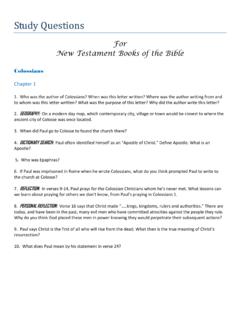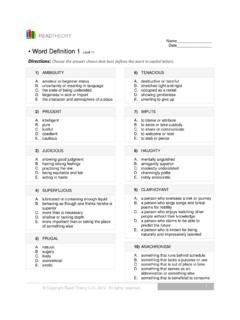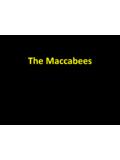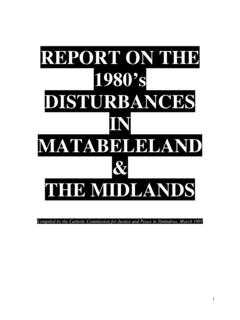Transcription of IshaqzaI TrIbe - Tribal Analysis Center - TAC
1 TRIBALANALYSIS CENTERC ultural & Geographic ResearchIs h a q z aI Tr I b eNOV 2009 Tribal Analysis Center , 6610-M Mooretown Road, Box 159. Williamsburg, VA, 23188 IshaqzaI TrIbe : Origins of Their GrievancesIs h a q z aI Tr I b eC o p y r i g h t 2 0 0 9 Tr i b a l A n a l y s i s C e n t e r, LT DA l l R i g h t s R e s e r v e dAbout Tribal Analysis CenterTRIBALANALYSIS CENTERC ultural & Geographic ResearchTribal Analysis Center , 6610-M Mooretown Road, Box 159. Williamsburg, VA, 23188 IshaqzaI TrIbe : Origins of Their GrievancesIshaqzai TrIbe : Origins of Their Grievances Once there was The People - Terror gave it birth;Once there was The People, and it made a hell of earth!
2 Earth arose and crushed it. Listen, oh, ye slain!Once there was The People - it shall never be again! Rudyard KiplingThe IshaqzaI TrIbe , a member of the Panjpai group of the Durrani Confederation, has seen its fortunes wane considerably since the Durranis came to power in Afghanistan in 1747. Their loss of power and prestige was also accompanied by loss of livestock, many lost their nomadic lifestyle, and some were also deprived of a respected status as warriors. With their loss of prestige came a derogatory name that was applied to them as many impoverished IshaqzaI nomads were forced by circumstance to become farmers.
3 To the other Durranis, they became Sogzai, or the Vegetable People. With their losses came estrangement from the government leaders in Kabul, the very Barakzai monarchs drawn from their fellow Durranis, who made the decisions that cost the IshaqzaI so dearly. This estrangement continues today with more IshaqzaI leaders affiliated with the Taliban than with the Kabul administration of Hamid Karzai, a fellow IshaqzaI tribesmen appear to be sensitive to their social status in the competition for primacy within the Pashtun particularly the Durrani confederation power structure.
4 Their original Tribal area is probably located in Helmand Province and Antonio Giustozzi explains their competition with the Alizai TrIbe , another Durrani Pashtun TrIbe . Both are members of the Durrani Panjpai subconfederation, but this doesn t slow their competition. Giustozzi explains: .. IshaqzaI communities, which had been very influential in Helmand under the Taliban regime, at the expense of the Alizais who had dominated the province until 1994. With the fall of the Taliban, Alizai circles around Sher Mohammad Akhundzada were again elevated to the power they had been holding in 1981-94 and proceeded to marginalize and tax IshaqzaI communities.
5 In 2006, a violent conflict broke The Taliban exploited the conflict to consolidate their influence in Sangin district, where the IshaqzaI are the majority of the population, but this did not prevent them from maintaining their pockets of support among Alizai clans hostile to Sher Mohammad, such as in Baghran and in other parts of northern Helmand. 21. Sher Mohammad Akhundzada was removed from the governorship in Helmand in 2006. Regardless of his personal shortcomings, Sher Mohammad knew how to manage Tribal balance of power better than many of Afghanistan s Giustozzi, Antonio, Koran, Kalashnikov, and Laptop: The Neo-Taliban Insurgency in Afghanistan, pp.
6 Analysis Center , 6610-M Mooretown Road, Box 159. Williamsburg, VA, 23188 IshaqzaI TrIbe : Origins of Their GrievancesLeaders:Taliban Maulvi Abdul Sattar Sanani: Chief Justice of the Kandahar Supreme Court, member of the most senior Taliban at the age of Akhtar Mohammad Osmani: Taliban Kandahar Corps commander, killed 19 December Akhtar Mohammad Mansoor: Taliban Minister of Civil Aviation, member of Quetta Nur Ali Haidery: Director of Ariana Afghan airlines who has since reconciled with the government of Afghan Government Maulavi Abdullah Fayez: leader of the Council of Scholars in Kandahar and a pro-government cleric, assassinated on 29 May Other attempts were made on his life, including a bomb attack on his mosque in July, Malalai IshaqzaI : A female member of Parliament from Kandahar province s Panjwaii : Generally Sunni Islam, tribally Panjpai Durrani, and the rural IshaqzaI are generally estranged from the central government.
7 This TrIbe is oriented substantially toward the insurgency and the drug industry. The context of the period in which the IshaqzaI suffering occurred is important to understand. It shows well that the Afghan people suffered with great tyranny long before the Soviet Union sent its troops across the Oxus River. Jonathan L. Lee describes the situation in Afghanistan during the 1880 s better than most: The secret history of what a senior British official termed the Reign of Terror contained within the India Office diaries reveal the extent to which Britain s foreign policy success was achieved only at the price of the blood of the peoples over whom the Amir wielded absolute and untrammeled power.
8 During the course of twenty-one years Abd al-Rahman Khan probably had as many as 100,000 persons judicially executed, whilst hundreds of thousands more perished from hunger, forced migrations, epidemics, or died as a result of the numerous campaigns which the Amir conducted against various ethnic, Tribal and sectarian interests. The fear that the Amir s atrocities engendered was a shadow which fell across the lives of everyone in Afghanistan. From the heir apparent to the water carrier no-one was exempt from what the Kabulis called the Power that walks in darkness.
9 3. of taliban accessed 11 October Giustozzio, pg. 47, accessed 11 October Giustozzi, pg. 47, accessed 11 October http:// accessed 11 Oct accessed 11 Oct 2009. 8. accessed 11 Oct accessed 11 Oct Analysis Center , 6610-M Mooretown Road, Box 159. Williamsburg, VA, 23188 IshaqzaI TrIbe : Origins of Their Grievances ..for the people of Afghanistan, from the IshaqzaI tribesmen of Badghis Province .. it is the atrocities which dominate the folk memories which have survived from this era. 10 But the IshaqzaI had not always been the Vegetable People.
10 They were nomad maldars11 who owned large flocks that left them independent as they wandered across ancient migration routes to summer and winter grazing areas. Their men were warriors and their chiefs were respected leaders who participated in the councils of the great men of the time. One of their near legendary leaders, Musa Khan, also called Musa Dungi,12 managed to escape the Persian siege of Herat to find salt and grain for his men before returning to the besieged city to share their fate. Later, after the city surrendered to the Persian leader Nadir Shah, and the captured Durranis were forced into Persian service, Musa Khan accompanied Nadir Shah in much of his remaining campaign13.








